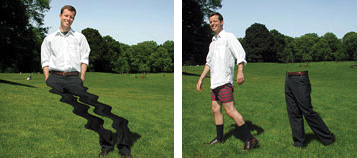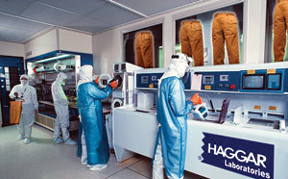Haggar Physicists Develop 'Quantum Slacks'
 Quantum slacks featured in Haggar's spring 2001 catalog. |
DALLAS-At a press conference Monday, Haggar physicists announced the successful development of "Quantum Slacks," attractive, wrinkle-free pants that paradoxically behave like both formal and casual wear. "With this breakthrough, pants enter a whole new dimension," said Dr. Daniel Chang, head of the Haggar team. "Conventional notions about the properties and possibilities of slacks have been completely turned on their head."
Though long dreamed-of by theoretical physicists and science-fiction authors, the quantum slacks represent the first wearable pair of non-Newtonian pants, putting America one step closer to a complete casual wardrobe that transcends classical physics. "For decades, we conducted level-one physics experiments in which we collided individual subatomic particles in a highly controlled laboratory setting," Chang said. "But an array of technical hurdles kept us from taking the next logical step: colliding pants."
Preliminary tests conducted last month at the Haggar Pants Propulsion Laboratory in Dallas indicate that the quantum slacks, generated by smashing together two larger sizes of slacks at near-light speeds, defy scientific explanation. Said Chang: "We placed the pants in a casual lawn-party setting and discovered them to be functional and comfortable. But, against all logic, in subsequent tests the pants performed equally well at a formal business luncheon. This represents a baffling, 'Schrödinger's Pants' duality. The results even fly in the face of Einstein, who preferred wool trousers."
 Scientists at Haggar's Pants Propulsion Laboratory bombard khakis with high-speed pleat particles. |
More exciting, Kohl said, is the potential for gaining insight into the very origin of trousers itself-a breakthrough he described as "within walking distance." "Scientific law holds that any given piece of clothing becomes less fashionable over time," Kohl said. "However, at the quantum level, we have found that certain styles of Haggar slacks actually grow more fashionable, suggesting the existence of 'slachyons,' theoretical pants that travel backward in time."
In the face of these bizarre phenomena, the Haggar physicists remain optimistic. "Mankind's knowledge of pants technology has been advanced immeasurably," Kohl said. "We cannot overstate the revolutionary nature of this breakthrough. We are on the verge of unzipping the secrets of creation and peering into the pants of God Himself. We are about to discover the very fabric of the universe, and it appears to be a smart cotton-twill weave."
This article first appeared in The Onion-America's Finest News Source (www.theonion.com) copyright 2001. Reprinted with permission.
©1995 - 2024, AMERICAN PHYSICAL SOCIETY
APS encourages the redistribution of the materials included in this newspaper provided that attribution to the source is noted and the materials are not truncated or changed.
Associate Editor: Jennifer Ouellette
October 2001 (Volume 10, Number 9)
Articles in this Issue

